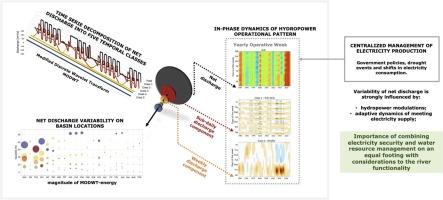River flow response to changing electricity demand and centralized hydropower operations in the Paranapanema River basin, Brazil
IF 5
2区 地球科学
Q1 WATER RESOURCES
引用次数: 0
Abstract
Study region
The Paranapanema River Basin, located in southeastern Brazil, is characterized by a cascade of large hydropower plants regulated by a nationally coordinated dispatch system. This basin is a representative case of reservoir-regulated rivers in the country, where multiple dams interact to supply electricity while reshaping natural flow regimes.
Study focus
This study examines hydropower-induced variability in river discharge and reservoir volumes using multiresolution wavelet decomposition and signal reconstruction. By analyzing continuous records under operational conditions, the method isolates fluctuations from sub-daily to multi-annual scales. This approach moves beyond average-based analyses, providing a scale-specific view of hydropower modulation. It shows how discharge dynamics arise not only from cascade configuration but also from dispatch coordination, plant design, and hydrological conditions.
New hydrological insights for the region
Results show that flow variability patterns align with electricity demand profiles, drought episodes, and institutional milestones in the Brazilian power sector. Hydropower operations display distinct signatures at different time scales, highlighting the responsiveness and complexity of reservoir management. Reconstructing signals in original units improves interpretability and supports regulatory evaluation and energy planning. The proposed framework provides a standardized and reproducible way to assess variability in reservoir-regulated systems, enhancing comparability of hydropower assessments and identifying operational dynamics that shape river flow regimes. It also supports more adaptive and ecologically grounded approaches to hydropower governance in the Paranapanema Basin and beyond.

巴西帕拉纳帕内玛河流域河水流量对电力需求变化的响应及集中水电运行
研究区域位于巴西东南部的帕拉那帕内玛河流域,其特点是由全国协调调度系统管理的大型水电站梯级。该盆地是该国水库调节河流的典型案例,其中多个水坝相互作用,在重塑自然水流制度的同时提供电力。本研究利用多分辨率小波分解和信号重建技术研究了水力发电引起的河流流量和水库容量的变化。通过分析运行条件下的连续记录,该方法分离了次日尺度到多年尺度的波动。这种方法超越了基于平均值的分析,提供了水电调节的特定规模视图。它显示了流量动力学不仅来自级联配置,还来自调度协调、电厂设计和水文条件。结果表明,流量变化模式与巴西电力部门的电力需求概况、干旱事件和制度里程碑相一致。水电运行在不同的时间尺度上表现出不同的特征,突出了水库管理的响应性和复杂性。在原始单元中重建信号可以提高可解释性,并支持监管评估和能源规划。拟议的框架提供了一种标准化和可复制的方法来评估水库调节系统的可变性,提高水电评估的可比性,并确定影响河流流量状况的操作动态。它还支持在帕拉纳帕内马盆地及其他地区采用更具适应性和生态基础的水电治理方法。
本文章由计算机程序翻译,如有差异,请以英文原文为准。
求助全文
约1分钟内获得全文
求助全文
来源期刊

Journal of Hydrology-Regional Studies
Earth and Planetary Sciences-Earth and Planetary Sciences (miscellaneous)
CiteScore
6.70
自引率
8.50%
发文量
284
审稿时长
60 days
期刊介绍:
Journal of Hydrology: Regional Studies publishes original research papers enhancing the science of hydrology and aiming at region-specific problems, past and future conditions, analysis, review and solutions. The journal particularly welcomes research papers that deliver new insights into region-specific hydrological processes and responses to changing conditions, as well as contributions that incorporate interdisciplinarity and translational science.
 求助内容:
求助内容: 应助结果提醒方式:
应助结果提醒方式:


